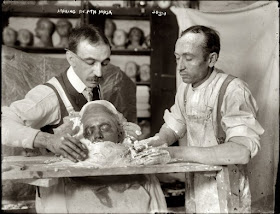 Making a plaster death mask, New York, c. 1908. George Grantham Bain Collection, Library of Congress.
Making a plaster death mask, New York, c. 1908. George Grantham Bain Collection, Library of Congress. A plaster cast of the face and hands of theologian and religious reformer Martin Luther (1483-1546), made shortly after his death and now on exhibit at Luthers Sterbehaus [Luther's Death House] in Eisleben, Germany, where he spent the last few weeks of his life.
A plaster cast of the face and hands of theologian and religious reformer Martin Luther (1483-1546), made shortly after his death and now on exhibit at Luthers Sterbehaus [Luther's Death House] in Eisleben, Germany, where he spent the last few weeks of his life. Cast of death mask of Australian wife-murderer Frederick Bailey Deeming, hanged at Old Melbourne Gaol in 1892. The shape of Deeming's skull was held by phrenologists to indicate that he was an innate criminal, but the judge in his case rejected his plea of insanity.
Cast of death mask of Australian wife-murderer Frederick Bailey Deeming, hanged at Old Melbourne Gaol in 1892. The shape of Deeming's skull was held by phrenologists to indicate that he was an innate criminal, but the judge in his case rejected his plea of insanity. Death mask with wounds added, used as a visual aid to demonstrate the characteristics of incisions, lacerations, and stab wounds, c. 1965. New York City Medical Examiner's Collection, National Museum of Health and Medicine, Washington, D.C.
Death mask with wounds added, used as a visual aid to demonstrate the characteristics of incisions, lacerations, and stab wounds, c. 1965. New York City Medical Examiner's Collection, National Museum of Health and Medicine, Washington, D.C.It is easier to make plaster molds of the faces of the dead than the living - they don't move and they don't require straws in the nostrils through which to breathe. I came across the top photo yesterday on one of my favorite blogs, Morbid Anatomy, in reference to the article "Death Doesn't Lie." Then began a lengthy search for more information about death masks, starting with the book cited in the comments to the Morbid Anatomy post. In Portraits in Plaster, American essayist and critic Laurence Hutton (1843-1904) documents his extensive collection of life and death masks - but in A Pictorial Guide by John Delaney, Princeton University Library has kindly digitized the entire array (click on the alphabet). Note that the cast of Abraham Lincoln's face - often mistakenly assumed to be made after his death, is correctly identified as a life mask, as is further explained on a blog called Project Death Mask. There are plenty of death masks to be found on the web - politicians, scientists, artists, writers, and particularly musicians - but they are also available for sale from Teardrop Memories if you want to hold one in your hands. I chose the images above to represent the reasons death masks have been made: not just sentimental, but historical, pseudoscientific, and forensic. They are the direct imprint of the human face, predating and paralleling photography. Hutton writes:
The value of a plaster cast as a portrait of the dead or living face cannot for a moment be questioned. It must, of necessity be absolutely true to nature. It cannot flatter; it cannot caricature. It shows the subject as he was, not only as others saw him, in the actual flesh, but as he saw himself. And in the case of the death-mask particularly, it shows the subject often as he permitted no one but himself to see himself. He does not pose; he does not "try to look pleasant." In his mask he is seen, as it were, with his mask off!
They may be so unflattering, in fact, that posterity prefers a print or photographic portrait...
No comments:
Post a Comment
You may add your comments here.